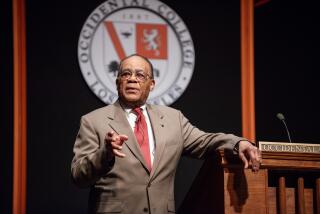PASSINGS
FOR THE RECORD:
Salpeter obituary: The obituary of astrophysicist Edwin E. Salpeter in Monday’s California section said that the “Salpeter-Bethe equation” showed how helium changes to carbon. In fact, that equation by Salpeter and Cornell colleague Hans Bethe describes bound states of a pair of interacting particles in quantum field theory. —
Edwin E. Salpeter
Showed how helium fuses
Edwin E. Salpeter, 83, an astrophysicist whose work in the “Salpeter-Bethe equation” showed how helium changes to carbon, died of leukemia Tuesday at his home in Ithaca, N.Y., according to Cornell University, where he had been a professor emeritus of physical sciences.
Salpeter attended Cornell in 1949 as a postdoctoral student and spent his career there.
In 1951, he and Cornell theoretical physicist Hans Bethe, winner of the 1967 Nobel Prize in physics, introduced an equation showing how helium nuclei fuse to form carbon in the interiors of ancient stars. Until then, the origin of elements beyond helium in the periodic table was a mystery.
From that work, Salpeter determined the formation rates of stars of various masses in the galaxy.
It remains the basis of studies into the rates of stellar births and deaths.
In 1964, while working independently, Salpeter and Soviet physicist Yakov Zeldovich were the first to propose that a stream of gas falling toward a black hole could be heated to produce detectable X-rays. Thirty years later, data from the Hubble telescope confirmed their idea.
In 1997, Salpeter and Sir Fred Hoyle, a British scientist who coined the term “Big Bang,” shared the $500,000 Crafoord Prize from the Royal Swedish Academy of Sciences for their work in the study of nuclear reactions in stars.
The annual prize marks accomplishments in scientific fields that are not covered by the Nobel Prizes, whose winners also are chosen by the academy.
Born in Vienna on Dec. 3, 1924, Salpeter moved with his family to Australia in 1939. He earned a bachelor’s degree in physics and mathematics at the University of Sydney in 1944 and a doctorate at the University of Birmingham in England in 1948.
John Robert ‘Red’ Murff
Mets scout found Nolan Ryan
John Robert “Red” Murff, 87, the New York Mets scout who discovered Hall of Fame pitcher Nolan Ryan, died Friday at a nursing home in Tyler, Texas. The cause of death was not given.
Murff filed this report on 17-year-old Ryan of Alvin, Texas, in 1964:
“Skinny right-handed junior. Has the best arm I’ve ever seen in my life. Could be a real power pitcher someday.”
Although Ryan stood 6 feet 2 and could throw a baseball 100 mph, he weighed only 150 pounds as a high school player and often had no idea where his fastball was going, putting off most scouts who came to watch him pitch.
“Murff was different because he met my parents once,” Ryan recalled later. “He saw how big my dad was [6 feet 4, 240 pounds]. He saw my genetic potential.”
The Mets took a chance, making Ryan the 295th player taken in the 1965 draft. He was inducted into the Baseball Hall of Fame in 1999 and is now president of the Texas Rangers.
Born April 1, 1921, in Burlington, Texas, Murff pitched for the Milwaukee Braves from 1956 to 1957, going 2-2 with three saves and a 4.65 earned-run average in 26 appearances.
-- Times staff and wire reports
More to Read
Start your day right
Sign up for Essential California for the L.A. Times biggest news, features and recommendations in your inbox six days a week.
You may occasionally receive promotional content from the Los Angeles Times.






